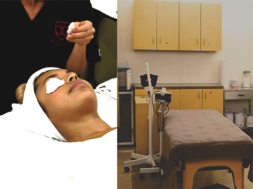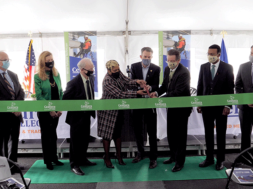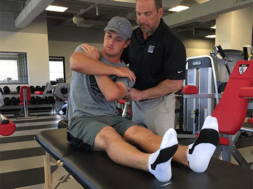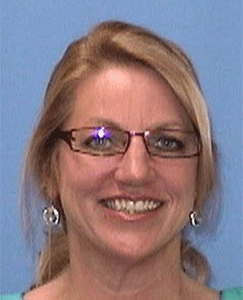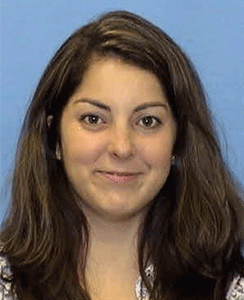
By Melody Sharp, Dean and Holly Puckett, Accreditation Specialist, Centra College of Nursing
Background
Centra College of Nursing (CCON), originally known for Lynchburg General Hospital School of Nursing, was founded in 1912. CCON has been institutionally accredited by the Accrediting Bureau for Health Education Schools (ABHES) since 2013. With the initial accreditation, only two programs were approved at the time: Associate Degree in Nursing and Practical Nursing programs. In the last three years, additional programs were approved: RN-BSN and a Nurse Aide Certificate. Centra College of Nursing is governed and affiliated with Centra Health, Inc. Within this parent organization, four hospitals serve the regional area. In addition, there are many out-patient and rehabilitation settings affiliated with the governing organization that CCON students go to for pediatrics, mental health, OB, and long-term care. There are an additional two colleges in the city of Lynchburg (Liberty University and The University of Lynchburg) that complete clinical hours for their health science major students such as nursing, pre-med, phlebotomists, respiratory therapists, PT/OT/SP within the same healthcare organization. With the amount of students from various programs and at different levels within each department, many consumers of this organization have become overburdened with the amount of surveys distributed throughout the year.
It is common for many institutions and universities to utilize surveys and questionnaires to gain feedback, evaluate satisfaction, and measure participation from the following resources: current students, employers, graduates, and clinical staff (participants).
Surveys can also be used to assess buy-in for institutional changes as well as for educational activities in an institutional setting.
Surveys ultimately guide educational institutions to obtain a perception of strengths and weaknesses and to develop an action plan for improvement when necessary.
Literature
Surveys, from distribution to evaluation, must have a plan in place. A well-defined plan allows for ease in process for both the survey administrator and participants. When a plan is not set forth, challenges can occur (Pell Institute, 2019). Educational institutions rely on surveys and questionnaires provided to participants to further improve the quality of teaching students receive and the processes the institution enforces. It is imperative that educational institutions regularly update administrative staff and faculty with the on-going survey results. The future of learning is greatly influenced from survey and questionnaire feedback. “Closing the loop” or the “feedback loop” involves the idea that institutions should seek to implement continuous improvement of the learning environment, linking educational provision with feedback, evaluation and review (Lake et al., 2017). If educational institutions neglect to close the loop, what would be the significance of distributing a survey?
Initial methodology
Centra College of Nursing initially used a paper method to disseminate employer surveys throughout the years of 2012 and 2015. No other strategy or method was utilized during those years. Administrative staff focused on employer survey results to figure out a plan for improvement as it was extremely noticeable when the response rates fell from 59 percent in 2014 to 34.2 percent in 2015. Educational institutions want participants to feel excited and ecstatic to provide feedback on a survey. However, most participants feel overwhelmed with the amount of on-going surveys from various academic institutions and surveys from within their own organizations.
Therefore, it is imperative to utilize multiple survey strategies especially with the amount of surveys in order to maintain a productive response rate.
Centra College of Nursing implemented a different strategy approach other than the traditional paper form. A SurveyMonkey link was utilized as a new approach in August 2015. Response rates climbed back up to 50 percent in August 2015. This same approach was used for the next few semesters – there was a decrease in response rates.
On-going survey response rates
With the ever-evolving technological advances and various methods of communication, it is important to keep up-to-date with technology to capture the interest of participants. Faculty and administrative staff reviewed the decrease in response rates and began a literature search on survey strategies. By implementing a single survey strategy, response rates will decrease over time, therefore, a decision was made to utilize one of seven different survey design strategies each semester in order to maintain and increase response rates. Centra College of Nursing supported the need to change the survey design strategy each semester in the order of sequence through the various methods below:
- Personal email survey link invitations
- Phone calls
- Survey meeting with personal face-to-face interaction with computers and reward
- Individual visits with iPad survey link and reward
- Recruit prior alumni 2-3 years or more experience to distribute survey link invitation
- Drop-off/Pick-up
Centra College of Nursing concluded that by utilizing a different survey strategy each semester, especially for employer surveys, response rates continue to elevate above 50 percent. Centra College of Nursing has piloted the seven survey design strategies over the last year.
These design strategies resulted in Centra College of Nursing survey response rates at 75 – 100 percent.
Low survey response rates and non-response errors have presented challenges, especially for educational institutions. Utilizing the drop-off/pick-up survey strategy has been proven through research as a great alternative to the traditional mail, web-based surveys. By using this strategy, an increase in response rates typically occur due to the following reasons:
- Personal face-to-face interaction
- Reduction in errors
- Increased clarity
- Engagement
Face-to-face interaction is invaluable as it allows the consumer to personally see the individual distributing the survey and to put a face with a name. Clear directions on how to complete the survey permit less time for errors. Increased clarity states the purpose and why it is important to you as the educational institution. Lastly, engagement shows an interest from the educational institution to the consumer, whether it is a personal note, incentive, or reward (Trentelman et al., 2016).
Tips for Survey Success
- Avoid holidays, fall, spring, and summer breaks for survey administration
- Limit the number of questions to what you really need to know
- Provide clear and easy-to-follow instructions
- Use clear and simple language
- Avoid abbreviations
- Make a good first impression
- High-quality survey design
- Utilize a fifth-grade reading level
- Try using incentives
- Make sure the survey is accessible
- Provide contact information
- Utilize a survey administrator
- Send a personalized pre-notification letter, email, or postcard
- Send a reminder one week after a survey is distributed
- Send a second reminder with a deadline date for survey completion prior to survey closure (CDC, 2010)
Surveys should be able to be completed in under two to three minutes. By limiting the number of questions to what is required and mandated by accrediting bodies, the length of time to complete the survey will be reduced and participation more attainable. Incentives such as goody bags or gift cards usually are very helpful to increase response rates when it is feasible. Lastly utilizing a survey administrator as a designated individual who will distribute the survey, collect the survey results, and provide notifications and reminders is essential. The survey administrator should provide appropriate measurement tools and the survey should be presented in a logical, clear manner. A survey administrator should send a personalized pre-notification letter, email, or postcard one week prior to mailing the questionnaire informing participants of what’s to come. The survey administrator should then indicate when participants should expect to receive the survey and explain its purpose and why their feedback is important. A reminder can be sent via numerous strategies one week after the survey is distributed to thank participants for their response or to encourage them to respond if they have not already done so (CDC, 2010).
Conclusion
Surveys often present obstacles for educational institutions when expectations and benchmarks are not achieved for response rates. Utilizing a different survey strategy design and approach each semester for particular surveys has proven to increase response rates from below 50 percent to greater than 75 percent. In addition, following the Tips for Survey Success is essential in the administration for any survey.
Scenarios of classic survey events – How would your educational institution approach these?
Scenario I
You are the survey administrator and you have created a Graduate Survey using SurveyMonkey. This is the first time you have ever used this resource for a survey. You send an email with the survey link to the participants informing them of what the survey is for and for them to complete it. You notice in two weeks that you do not have any responses. What do you think happened? Is there anything that you could have done better to increase participation?
Scenario II
You are the survey administrator and you have sent out a paper survey for the Employer Survey. You have used this same survey strategy for the last three times of distributing the Employer Survey. One week after the survey was distributed, you send a reminder to complete the survey. You notice in week two that you’ve only received approximately 20 percent participation. Is there anything that can be done before the survey is closed? What should this survey administrator do now? What can the survey administrator do prior to the next Employer Survey?
Scenario III
You are the survey administrator and you have sent out a letter informing graduates and employers on how this semester surveys will take place. You plan to have four other faculty/administration members involved in the process. The new process will be to take the survey to the clinical areas using SurveyMonkey on iPads to the employers and graduates. The team has set aside two days for the Employer Survey and will provide a list of the graduate names, to help them recognize the names of graduates they may have hired. The team will also set aside two days for Graduate Survey using the same iPad survey process on the clinical units (MEET THEM WHERE THEY WORK). You also explain that a small gift of appreciation will be provided upon completion. How should the survey administrator further implement this survey strategy? Is there anything that the administrator should worry about?
REFERENCES
Centers for Disease Control and Prevention. (2010). Increasing questionnaire response rates. Retrieved from: https://www.cdc.gov/healthyyouth/evaluation/pdf/brief21.pdf
Lake, W., Boyd, W., Boyd, W., & Hellmundt, S. (2017). Just another student survey? – Point-of-contact survey feedback enhances the student experience and lets researchers gather data. Australian Journal of Adult Learning, 57(1), 82–104.
The Pell Institute. (2019). Evaluation toolkit. Retrieved from: http://toolkit.pellinstitute.org/evaluation-guide/plan-budget/
Trentelman, C. K., Irwin, J., Petersen, K.A., Ruiz, N., & Szalay, C. S. (2016). The case for personal interaction: Drop off/pick-up methodology for survey research. Journal of Rural Social Sciences 31(3), 68-104.
DR. MELODY SHARP currently serves as Dean at Centra College of Nursing and Managing Director for Interprofessional Education at Centra Health, Inc. She has over 30 years of experience in nursing in both critical care and the academic settings in New York and Virginia. Dr. Sharp earned her A.D.N. at Beth Israel School of Nursing in NYC, B.S.N. at Old Dominion University, M.S.N. at West Haven University, and her D.N.P. at Case Western Reserve University.
Dr. Sharp has taught at all levels in nursing to include associates, baccalaureate and master’s. Her area of teaching expertise is in nursing research, health policy, and leadership. Her research focus areas are academic integrity, spirituality in healthcare, and bladder management in the rehab setting.
Contact Information: Dr. Melody F. Sharp // Dean // Centra College of Nursing // 434-200-7025 // melody.sharp@centracollege.edu // http://www.centracollege.edu // https://www.facebook.com/CentraCollege/
HOLLY PUCKETT serves as the Accreditation Specialist at Centra College of Nursing. She has nine years of experience in medical-surgical nursing and four years of experience in nursing education. She received her Bachelor of Science in Nursing from George Mason University and her Master of Science in Nursing from South University and currently is enrolled for her Doctorate in Nursing Practice with South University. She received her medical-surgical registered nurse certification in 2014 and is a member of the Academy of Medical Surgical Nurses and National League for Nursing. She taught at both the associate degree and practical nursing levels.
In her current role, she is accountable for retaining compliance with all accrediting bodies for the college and ensuring students’ graduate from an accredited program. She has composed many accreditation reports including a Self-Evaluation Report for the Accrediting Bureau of Health Education Schools and a Self-Study Report for National League of Nursing Commission for Nursing Education Accreditation in the last year.
Contact Information: Holly C. Puckett // Accreditation Specialist // Centra College of Nursing // 434-200-7025 // holly.puckett@centracollege.edu // http://www.centracollege.edu // https://www.facebook.com/CentraCollege/

